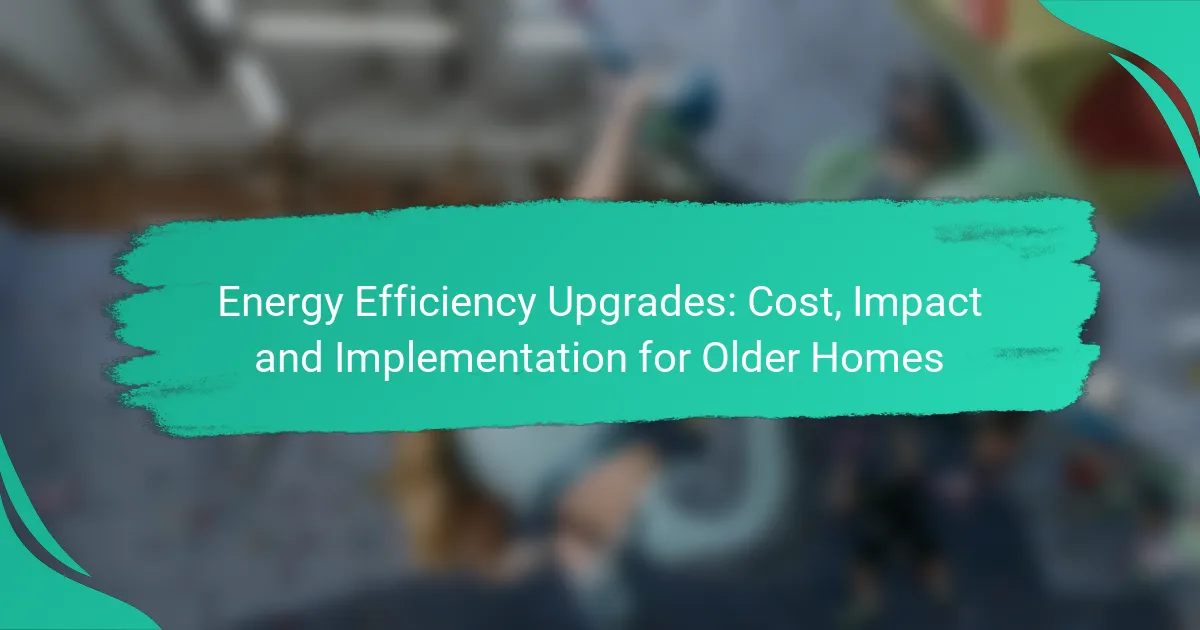Upgrading energy efficiency in older homes is essential for reducing energy consumption and enhancing comfort. Key improvements include better insulation, updated windows, and modern heating and cooling systems, which can lead to lower utility bills and increased property value. While costs can vary, the long-term benefits of these upgrades make them a worthwhile investment for homeowners seeking sustainability and savings.
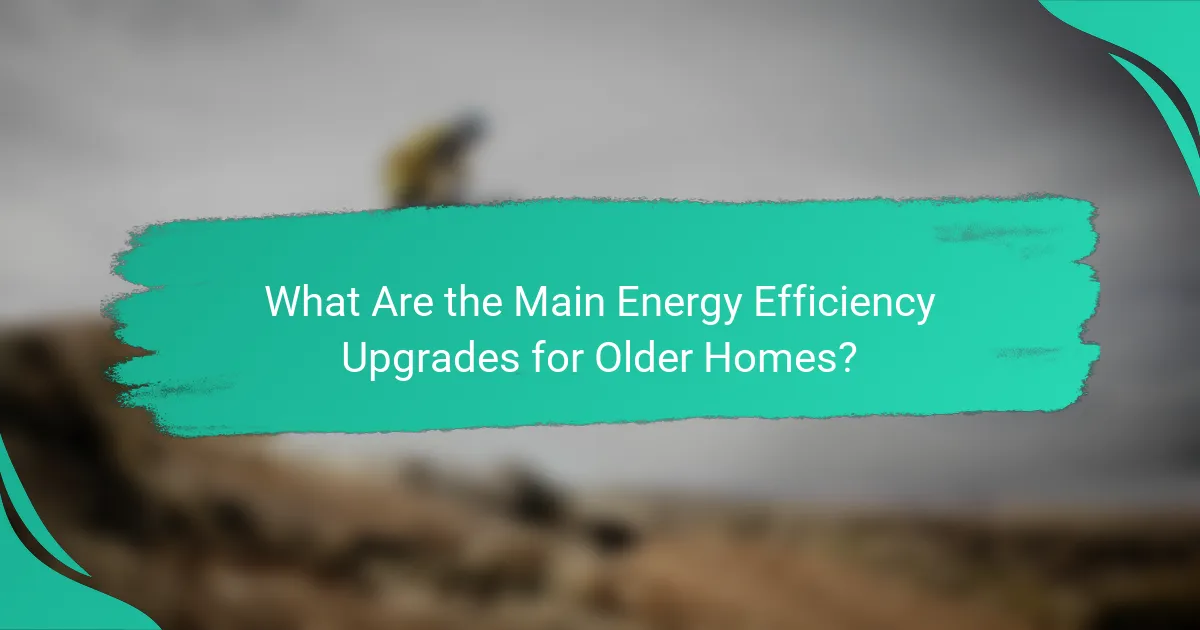
What Are the Main Energy Efficiency Upgrades for Older Homes?
The main energy efficiency upgrades for older homes include improvements to insulation, windows, heating and cooling systems, smart thermostats, and lighting. These upgrades can significantly reduce energy consumption, enhance comfort, and lower utility bills.
Insulation Improvements
Upgrading insulation is crucial for enhancing energy efficiency in older homes. Proper insulation helps maintain indoor temperatures, reducing the need for heating and cooling. Common areas to insulate include attics, walls, and basements.
Consider using materials like fiberglass, foam board, or spray foam, which can provide high R-values. Homeowners should aim for R-values that meet or exceed local building codes, often in the range of R-30 to R-60 for attics.
Energy-Efficient Windows
Replacing old windows with energy-efficient models can significantly decrease heat loss. Look for windows with double or triple glazing, low-E coatings, and gas fills that enhance thermal performance.
When selecting windows, consider the U-factor and Solar Heat Gain Coefficient (SHGC) ratings. Energy Star-certified windows can help guide your choices, ensuring compliance with efficiency standards.
Heating and Cooling System Upgrades
Modernizing heating and cooling systems can lead to substantial energy savings. High-efficiency furnaces and air conditioners often have SEER ratings above 14, which is significantly better than older units.
Regular maintenance, such as cleaning filters and ducts, can also improve system efficiency. When upgrading, consider the size of the unit to ensure it matches the home’s needs, avoiding oversized or undersized systems.
Smart Thermostats
Installing a smart thermostat allows for better control over heating and cooling schedules, optimizing energy use. These devices can learn your habits and adjust settings automatically, leading to energy savings of around 10-15%.
Choose a model compatible with your HVAC system and features like remote access and energy usage reports. This can help you monitor and adjust settings for maximum efficiency.
LED Lighting Installation
Switching to LED lighting is one of the simplest upgrades for energy efficiency. LEDs use about 75% less energy than traditional incandescent bulbs and last significantly longer, reducing replacement costs.
When replacing bulbs, look for lumens instead of watts to ensure adequate brightness. Consider using smart LED bulbs that can be controlled remotely or programmed for specific times, further enhancing energy savings.
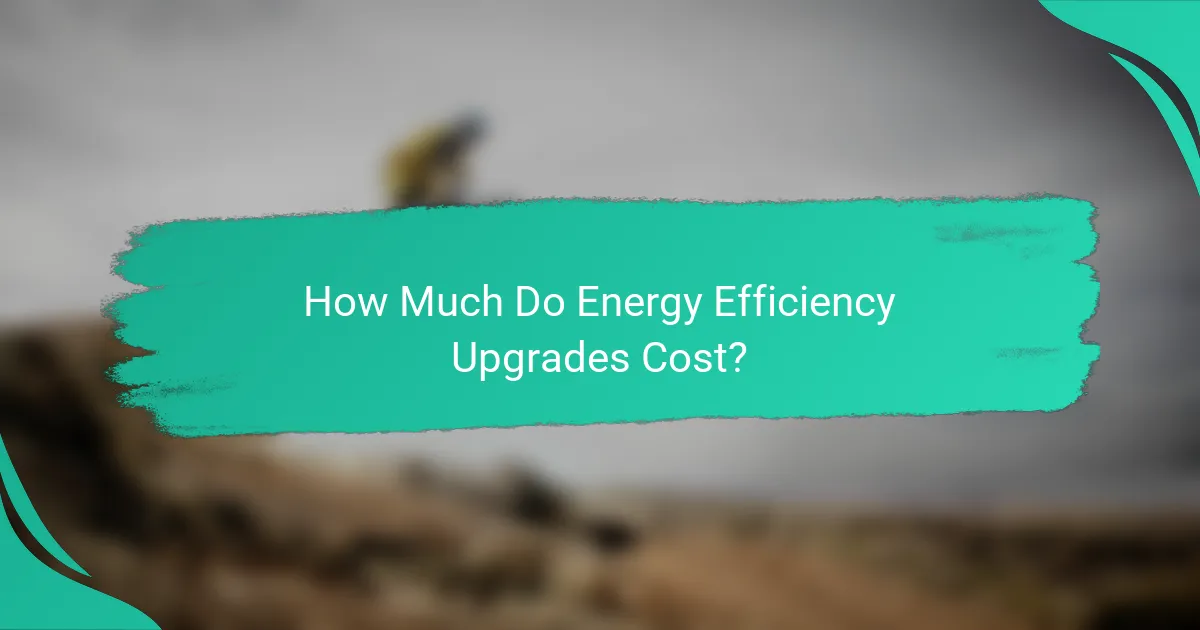
How Much Do Energy Efficiency Upgrades Cost?
The cost of energy efficiency upgrades for older homes can vary widely based on the type of improvement, the size of the home, and local labor rates. Generally, homeowners can expect to invest anywhere from a few hundred to several thousand dollars depending on the specific upgrades chosen.
Average Costs for Insulation
Insulation upgrades typically range from USD 1,000 to USD 3,000, depending on the type and area being insulated. Common materials include fiberglass, spray foam, and cellulose, each with different costs and R-values.
Consider the attic, walls, and floors when planning insulation improvements. Proper insulation can significantly reduce heating and cooling costs, often paying for itself within a few years through energy savings.
Window Replacement Costs
Replacing windows can be a significant investment, with costs ranging from USD 300 to USD 1,000 per window. Energy-efficient windows with double or triple glazing, low-E coatings, and gas fills are more expensive but can lead to substantial energy savings over time.
When replacing windows, consider the long-term benefits of improved insulation and reduced energy bills. Look for windows that meet ENERGY STAR standards to ensure optimal performance.
HVAC System Upgrade Costs
Upgrading an HVAC system can cost between USD 3,000 and USD 10,000, depending on the system type and home size. High-efficiency models often have higher upfront costs but can result in lower energy bills and improved comfort.
When considering an upgrade, evaluate the SEER (Seasonal Energy Efficiency Ratio) rating of new systems. A higher SEER rating indicates better energy efficiency, which can lead to significant savings over the system’s lifespan.
Cost of Smart Thermostats
Smart thermostats typically range from USD 100 to USD 300, depending on features and brand. These devices can optimize heating and cooling schedules, leading to energy savings of about 10-15% on heating and cooling costs.
Installing a smart thermostat is a straightforward DIY project that can enhance energy efficiency. Look for models that offer remote access, learning capabilities, and compatibility with existing HVAC systems for the best results.
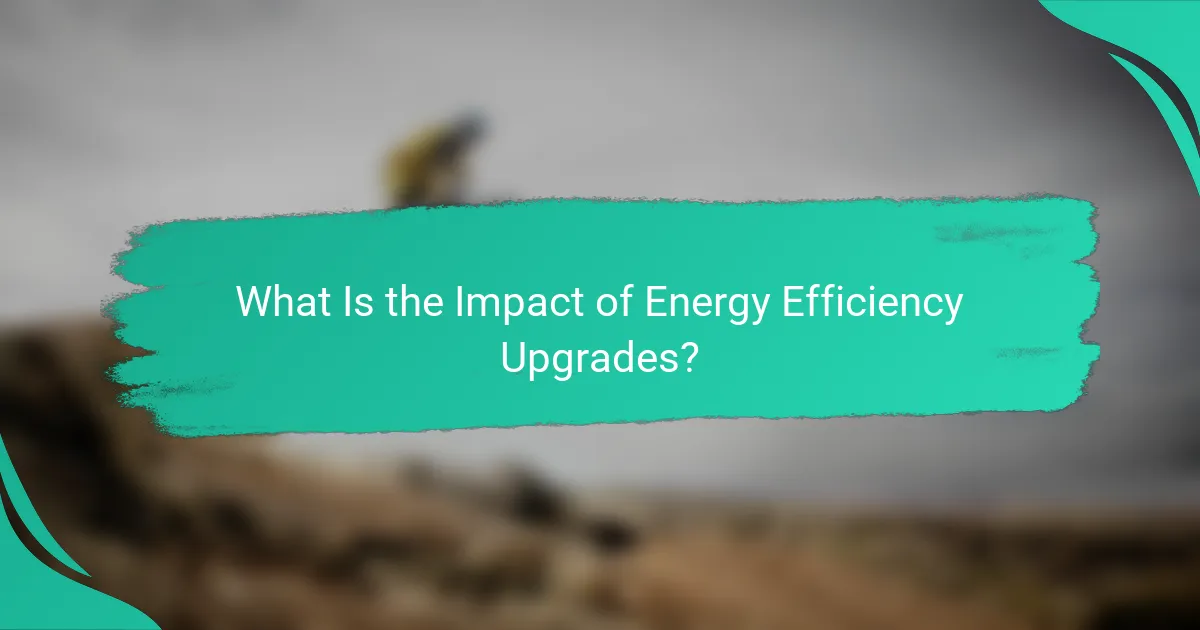
What Is the Impact of Energy Efficiency Upgrades?
Energy efficiency upgrades significantly reduce energy consumption, lower utility bills, and enhance the overall comfort of older homes. These improvements not only provide immediate financial benefits but also contribute to long-term sustainability and increased property value.
Reduction in Energy Bills
Implementing energy efficiency upgrades can lead to substantial reductions in monthly energy bills. Homeowners often see savings ranging from 10% to 30% after improvements such as better insulation, energy-efficient windows, and upgraded HVAC systems.
To maximize savings, consider conducting an energy audit to identify specific areas for improvement. Simple changes like sealing drafts and upgrading to LED lighting can yield quick returns on investment.
Increased Home Value
Energy efficiency upgrades can enhance the market value of older homes. Properties with energy-efficient features often attract buyers willing to pay a premium, as they promise lower operating costs and greater comfort.
Investing in upgrades such as ENERGY STAR-rated appliances or solar panels can increase a home’s resale value by several percentage points, making it a smart financial decision for homeowners looking to sell in the future.
Environmental Benefits
Upgrading to energy-efficient systems reduces greenhouse gas emissions and lessens the overall environmental impact of a home. By consuming less energy, homeowners contribute to decreased demand on fossil fuels and lower air pollution levels.
Additionally, many energy-efficient products are designed to be more sustainable, often using fewer resources during production and operation. This not only benefits the environment but also aligns with growing consumer preferences for eco-friendly living.
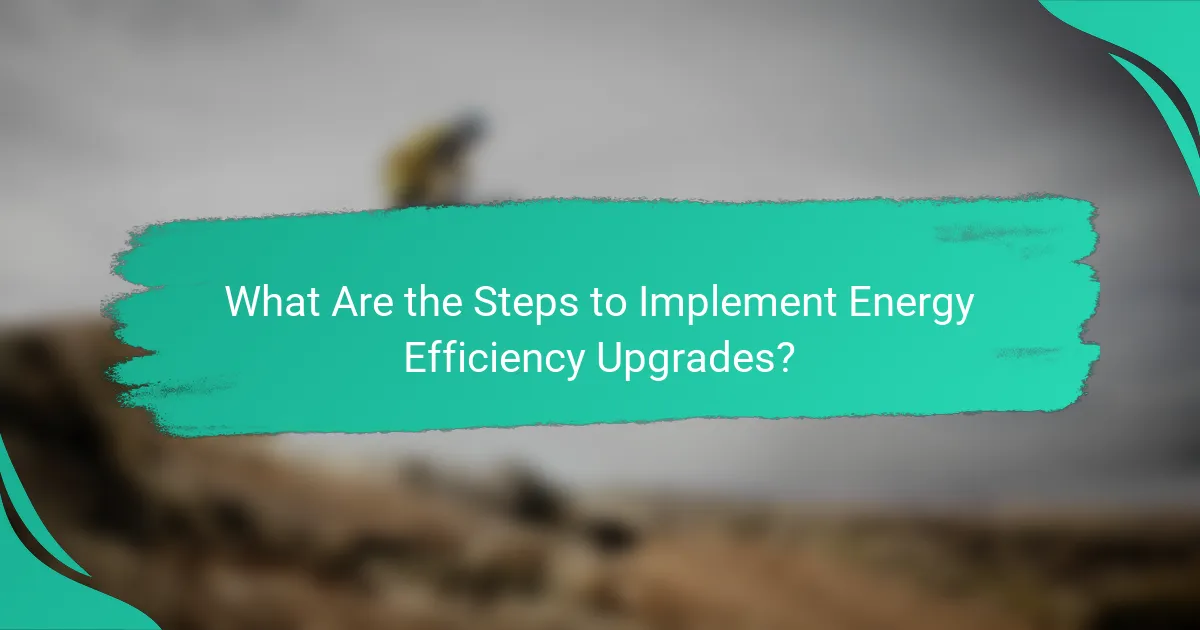
What Are the Steps to Implement Energy Efficiency Upgrades?
Implementing energy efficiency upgrades involves a systematic approach that enhances a home’s energy performance while potentially reducing utility costs. The process typically includes conducting an energy audit, selecting appropriate upgrades, and hiring qualified contractors to carry out the work.
Conducting an Energy Audit
An energy audit is a critical first step in identifying areas where your home can improve energy efficiency. This assessment evaluates insulation, heating and cooling systems, windows, and appliances to pinpoint energy loss.
Homeowners can choose between a DIY audit or hiring a professional. A professional audit may cost between $200 and $600, but it often provides a detailed report and recommendations that can lead to more effective upgrades.
Choosing the Right Upgrades
Selecting the right energy efficiency upgrades depends on the findings from the energy audit. Common upgrades include enhancing insulation, installing energy-efficient windows, and upgrading heating and cooling systems to more efficient models.
Consider the return on investment (ROI) for each upgrade. For instance, adding insulation can yield energy savings of 10-50% on heating and cooling costs, while energy-efficient windows may reduce energy bills by 7-15% annually.
Finding Qualified Contractors
Finding qualified contractors is essential for ensuring that energy efficiency upgrades are implemented correctly. Look for professionals with experience in energy-efficient renovations and check for certifications such as the Energy Star label or local green building certifications.
Request multiple quotes and ask for references to gauge the contractor’s reliability and quality of work. Additionally, verify that they are licensed and insured to avoid potential liabilities during the project.

What Incentives Are Available for Energy Efficiency Upgrades?
Various incentives are available for energy efficiency upgrades, including federal tax credits and state-specific rebates. These programs aim to reduce the financial burden of making homes more energy-efficient, ultimately leading to lower utility bills and a reduced environmental impact.
Federal Tax Credits
Federal tax credits offer homeowners a way to offset the costs of energy efficiency upgrades. These credits can cover a percentage of the expenses incurred for qualifying improvements, such as insulation, energy-efficient windows, and HVAC systems.
For example, homeowners may receive a credit of up to 30% for certain renewable energy systems, such as solar panels. It’s essential to check the specific eligibility requirements and deadlines, as these credits can change annually.
State Rebates
Many states provide rebates to encourage energy efficiency improvements. These rebates can vary significantly by state and may cover a range of upgrades, from energy-efficient appliances to home insulation.
To take advantage of state rebates, homeowners should research their local energy office or utility provider for available programs. Some states may offer instant rebates at the point of sale, while others require an application process after the purchase.
